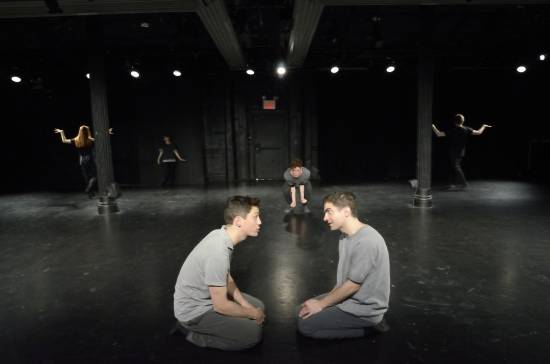Performance Space 122
150 First Ave. at Ninth St.
Through December 12, $20
www.ps122.org
The 1982 frightfest POLTERGEIST has become part of the American zeitgeist, representing the death-in-life horror of suburban living, complete with child abduction by an evil creature from another dimension. That’s where writer-choreographer Jack Ferver, who has made critics and audiences uncomfortable in such works as DEATH IS CERTAIN, MEAT, and WHEN WE WERE YOUNG AND FILLED WITH FEAR, found his inspiration for the hour-long RUMBLE GHOST, as he once again makes viewers squirm for a whole range of reasons. Fortunately, he also leaves them vastly entertained. As the audience filters into P.S. 122’s second-floor theater, Ferver and Christian Coulson are conducting a barely audible conversation, walking around and around the dark stage, populated by five unmoving figures. As the two men keep repeating the scene, their voices rise, and their journey continually shrinks; it is soon apparent that they are acting out the scene from POLTERGEIST in which Steve (Coulson) shows off their new house to his wife, Diane (Ferver). After each repetition, Ferver approaches the audience and pauses, as if to say, yes, get ready, because we’re going to do it again, and the audience, shifting in their seats, can’t help but think that they might be in for a whole lot more of this. After eight or nine trips, each more spatially confined than the previous (a clever way to evoke people’s familiarity with a movie they may have watched over and over and over again), the piece moves on, as the dancers — Benjamin Asriel, Reid Bartelme, Carlye Eckert, Michelle Mola, and Breanna O’Mara in addition to Coulson and Ferver — break off into experimental solos and duets as Carol Anne is sucked into a television set and a psychic (Eckert) is called in to try to find her. Save for two mirrors and two fluorescent lights, there are no other props or special effects, but Ferver is able to create tense — and funny — action playing off the audience’s memory of the film. If you’ve seen POLTERGEIST, you’ll be visualizing what is only being referred to onstage.
Just as Steve and Diane are about to go in after Carol Anne, the production shifts abruptly, as the seven players bring out chairs and sit in a circle for an Inner Child Work therapy session in which they all use their real names, ostensibly no longer in character. Ferver has brilliantly turned the movie family’s search for their child into the dancers’ search for their own inner child (while also equating a house with the psyche). By allowing the audience to watch this psychodrama, which is based on his personal experiences, Ferver once again evokes strong emotions ranging from the uncomfortable to the exhilarating, regardless of how “true” any of it might be. We are used to seeing performers perform onstage; we are not, however, used to seeing how they interact with one another offstage, and Ferver has playfully let us inside a rarely seen part of the creative process. Throughout RUMBLE GHOST, he continually surprises with his ability to challenge us by defying expectations, getting both into our faces and into our heads.
